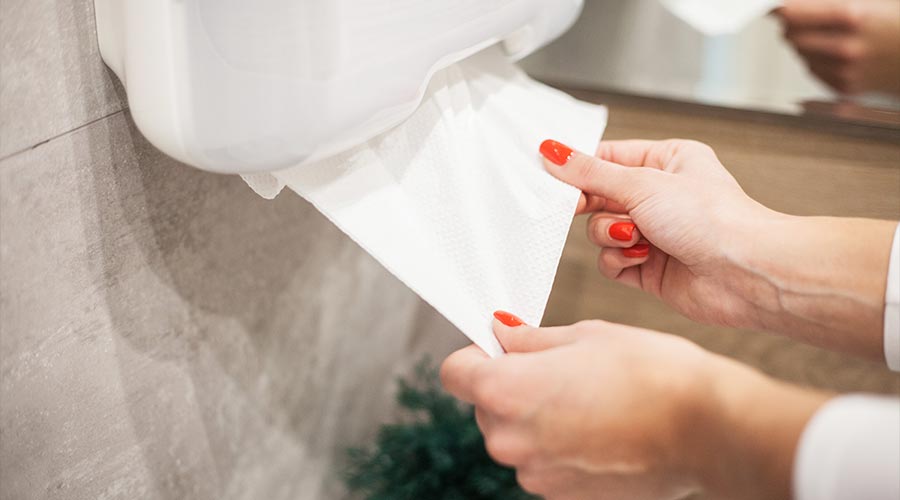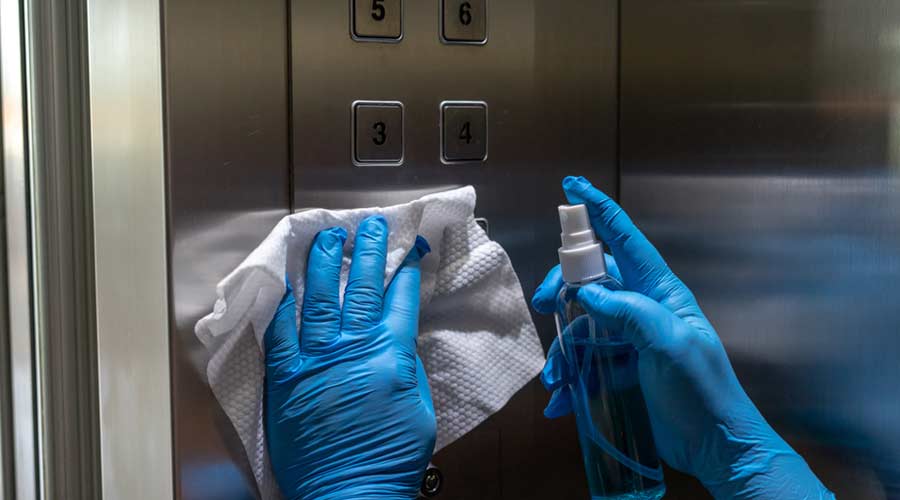
Restroom cleaning supplies eat up a bulk of facility maintenance budgets thanks to single-use products that require ongoing replenishment. This is the case for Trotwood-Madison City Schools in Trotwood, Ohio, where paper towels and toilet tissue are an astronomical expense for the district.
“In terms of custodial supplies, I spend more money on them than anything else,” says Scott Mayes, building grounds maintenance supervisor for the district. “An average skid of 48 cases of roll towels is right at $2,000.”
Although the district cares about the environment and implements many sustainable cleaning practices, Mayes shares that “green” paper towels and toilet tissue are not within the budget — and product samples put to the test have lacked durability.
Like Mayes, a growing number of facility managers are facing pressure to implement sustainable cleaning practices. But when it comes to stocking restrooms, many are wary of compromising quality or budgets that are already stretched thin by consumables.
Ryan Fagan, sales executive at Fagan Sanitary Supply in Pittsburgh, works closely with school districts to evaluate their sustainability programs and educate them about “green” paper options.
“It’s difficult for customers to look at anything other than the cost of a case of paper, but there’s definitely a demand for [sustainable paper products],” he says. “When there are customers, superintendents and board members who care, that seems to be the deciding factor.”
Dispelling Myths
Early on, “green” paper options earned a bad rap for subpar performance. But today’s environmentally friendly paper products are an acceptable — and often preferable — substitute for conventional paper supplies.
Eric Grantham, regional director of operations for Crothall Healthcare, Wayne, Pennsylvania, says that the company has been using recycled paper products for decades in its hospitals — and he has seen product improvements over time.
“The quality and ability to accomplish what’s needed has greatly improved over the last 10 years,” he says. “I don’t see any disadvantages to using it, and cost-wise it’s comparable to non-green paper products.”
Shaina Banks, product manager at Green Seal, Washington, D.C., confirms that many green-certified paper products are comparable in cost to conventional alternatives. She shares that recycled paper towels may not always be as soft or absorbent as 100-percent virgin towel products, but they perform effectively for their purpose.
No doubt, opinions differ regarding the quality of recycled paper products. But the adage “you get what you pay for” rings true — no matter which paper managers purchase.
“It’s a misconception that ‘green’ paper doesn’t work,” says Steve Ashkin, CEO of The Ashkin Group, Channel Island Harbor, California. “You can buy outstanding paper products made with 100-percent recycled content — just as you can buy low-quality virgin-fiber paper that doesn’t work well and falls apart. It’s a cost issue.”
To avoid the pitfalls of poor purchases, Ashkin advocates choosing green paper products that are certified by UL Solutions or Green Seal.
“When a company says this is 100 percent post-consumer recycled content paper, how do you know it really is?” he asks. “That’s why it’s so important to have independent, third-party companies verify manufacturers’ claims, so purchasers can buy with confidence.”
Although third-party organizations do not test the quality of sanitary paper products, experts recommend that facilities test products in-house to substantiate marketing claims pertaining to performance.
“Trialing products from multiple vendors can be helpful to identify those that best fit specific user needs,” says Banks.
Greening the Paper Trail
In addition to confirming manufacturers’ recycled content claims, third-party certification verifies where and how fibers are sourced. One of the most stringent certification systems is the Forest Stewardship Council (FSC). Facilities that purchase sanitary paper products bearing the FSC logo can rest assured the products are made from wood originating from responsibly managed forests.
“We push a lot of FSC’s initiatives and paper products, especially when they match up cost-wise,” says Fagan. “What’s great about FSC is they’re promoting transparency in the entire supply chain — from the forest to the final product.”
But FSC doesn’t only certify virgin wood. The council also certifies bamboo, a fast-growing grass that can have detrimental effects on local ecosystems if not managed responsibly.
“Products made from tree-free alternative fibers like bamboo also have environmental benefits compared to virgin tree fiber, as long as the materials are certified sustainably sourced,” says Banks.
Although the market for sustainably sourced bamboo products is growing almost as rapidly as the product itself, Banks notes there are less commercial bamboo products available in the North American market.
Like UL and Green Seal, FSC also certifies paper that includes recycled materials as well as products made from 100-percent recycled fiber.
“Recycled fiber products are an excellent choice for facility restrooms because they have the steepest environmental benefits,” says Banks. “One-hundred-percent recycled paper products achieve significant carbon and water savings compared to virgin tree-fiber products, which is why you often see these products in hotels, commercial office buildings, stadiums and other facilities that have sustainability targets or aspire to green building standards such as the U.S. Green Building Council’s LEED rating.”
When purchasing recycled paper, cleaning managers also have the option to buy products that do not use chlorine in the manufacturing process.
“Processed chlorine-free (PCF) is a bleaching method that only applies to recycled paper products,” Banks explains. “It means that the recycled and de-inked paper fibers are whitened without chlorine or chlorine derivatives, which are harmful to aquatic life.”
Green Seal–certified recycled sanitary paper products are always PCF, but many manufacturers of recycled paper also use PCF bleaching, according to Banks.
The True Price of Paper
Despite advances in “green” paper products, some facilities are still reluctant to make the change, citing higher upfront costs, quality concerns, or both. But proponents of sustainable paper options believe facilities can achieve long-term economic and environmental savings by switching to eco-friendly alternatives.
Fagan Sanitary Supply likes to highlight some of the implicit costs associated with opting for cheaper, virgin-fiber paper products in an effort to save money.
“It’s easy for someone to say we can’t afford that, and then shut it down,” he says. “But when you dig deeper, you find there are other costs associated with buying the cheapest products.”
For instance, some virgin-fiber paper products don’t break down efficiently, leading to potential plumbing issues. In contrast, eco-friendly paper is designed to biodegrade quickly, lessening the chance of clogged pipes, as well as the environmental impacts of disposal.
Additionally, Fagan considers how the paper is packaged for delivery and storage, ensuring that it supports worker productivity and isn’t wasteful.
“Custodial workers are such a huge asset, so we promote ergonomic boxes that have handles and are somewhat lighter for people,” he says.
Waste Not, Want Not
Unfortunately, most restroom paper supplies are destined for the landfill post-use.
“Sanitary paper products can’t be recycled because their fibers are typically too short and weak for reuse,” notes Banks. “They’re also often contaminated through use, making them unsuitable for hygienic recycling.”
Paper towels used for drying hands can be composted, and some composting programs accept facial tissues. Ashkin recommends facilities do some research to find out if there are composting services in their area.
“There are very few industrial composters in the U.S., so purchasers need to take the extra step to make sure they’re in a location where composting is available,” he notes. “Sometimes people think they’re sending their stuff out to be composted, but it’s either going to be burned or going to the landfill.”
Nevertheless, when it comes to reducing the environmental impacts of paper, facility managers’ should first focus their efforts on reducing consumption — regardless of paper type.
Experts recommend high-quality, absorbent paper and dispensing mechanisms that discourage overuse. Roll-towels are recommended over multifold-towel products and dispensers.
“C-fold towels are usually packed really tightly together,” notes Fagan. “When people reach into the dispenser, they grab a whole handful instead of one, and then throw them all in the trash.”
Although Trotwood-Madison City Schools has not invested in sustainable paper products, Mayes says the district has saved paper and money by investing in more absorbent, high-quality options, as well as switching to roll-towel dispensers.
Indeed, incorporating recycled paper products into restrooms — plus adopting measures to tackle waste and overuse — has numerous benefits for facilities. Recycled and/or sustainably sourced materials conserve natural resources, minimize landfill waste, and promote a healthier indoor environment for workers and building occupants.
But eco-friendly paper supplies are not only good for people’s health and the environment; they’re good for a facility’s reputation. By choosing “green,” facilities demonstrate their commitment to sustainability and socially responsible practices.
Kassandra Kania is a freelance writer based in Charlotte, North Carolina, and is a frequent contributor to Facility Cleaning Decisions.

 Celebrating BSCAI's 60th Anniversary eBook
Celebrating BSCAI's 60th Anniversary eBook The Down and Dirty on Cleaning in Virus Season
The Down and Dirty on Cleaning in Virus Season How Surfactant Use is Expanding in Commercial Cleaning
How Surfactant Use is Expanding in Commercial Cleaning